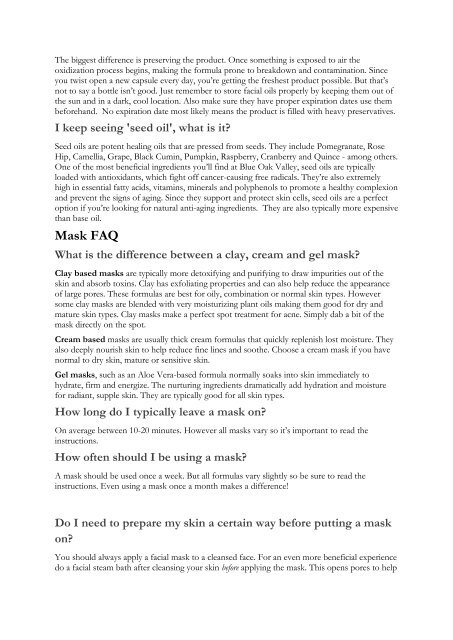FREQUENTLY ASKED QUESTIONS - Blue Oak Valley
FREQUENTLY ASKED QUESTIONS - Blue Oak Valley
FREQUENTLY ASKED QUESTIONS - Blue Oak Valley
You also want an ePaper? Increase the reach of your titles
YUMPU automatically turns print PDFs into web optimized ePapers that Google loves.
The biggest difference is preserving the product. Once something is exposed to air the<br />
oxidization process begins, making the formula prone to breakdown and contamination. Since<br />
you twist open a new capsule every day, you‟re getting the freshest product possible. But that‟s<br />
not to say a bottle isn‟t good. Just remember to store facial oils properly by keeping them out of<br />
the sun and in a dark, cool location. Also make sure they have proper expiration dates use them<br />
beforehand. No expiration date most likely means the product is filled with heavy preservatives.<br />
I keep seeing 'seed oil', what is it?<br />
Seed oils are potent healing oils that are pressed from seeds. They include Pomegranate, Rose<br />
Hip, Camellia, Grape, Black Cumin, Pumpkin, Raspberry, Cranberry and Quince - among others.<br />
One of the most beneficial ingredients you‟ll find at <strong>Blue</strong> <strong>Oak</strong> <strong>Valley</strong>, seed oils are typically<br />
loaded with antioxidants, which fight off cancer-causing free radicals. They‟re also extremely<br />
high in essential fatty acids, vitamins, minerals and polyphenols to promote a healthy complexion<br />
and prevent the signs of aging. Since they support and protect skin cells, seed oils are a perfect<br />
option if you‟re looking for natural anti-aging ingredients. They are also typically more expensive<br />
than base oil.<br />
Mask FAQ<br />
What is the difference between a clay, cream and gel mask?<br />
Clay based masks are typically more detoxifying and purifying to draw impurities out of the<br />
skin and absorb toxins. Clay has exfoliating properties and can also help reduce the appearance<br />
of large pores. These formulas are best for oily, combination or normal skin types. However<br />
some clay masks are blended with very moisturizing plant oils making them good for dry and<br />
mature skin types. Clay masks make a perfect spot treatment for acne. Simply dab a bit of the<br />
mask directly on the spot.<br />
Cream based masks are usually thick cream formulas that quickly replenish lost moisture. They<br />
also deeply nourish skin to help reduce fine lines and soothe. Choose a cream mask if you have<br />
normal to dry skin, mature or sensitive skin.<br />
Gel masks, such as an Aloe Vera-based formula normally soaks into skin immediately to<br />
hydrate, firm and energize. The nurturing ingredients dramatically add hydration and moisture<br />
for radiant, supple skin. They are typically good for all skin types.<br />
How long do I typically leave a mask on?<br />
On average between 10-20 minutes. However all masks vary so it‟s important to read the<br />
instructions.<br />
How often should I be using a mask?<br />
A mask should be used once a week. But all formulas vary slightly so be sure to read the<br />
instructions. Even using a mask once a month makes a difference!<br />
Do I need to prepare my skin a certain way before putting a mask<br />
on?<br />
You should always apply a facial mask to a cleansed face. For an even more beneficial experience<br />
do a facial steam bath after cleansing your skin before applying the mask. This opens pores to help


